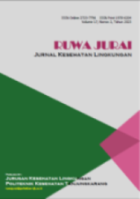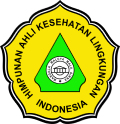Effect of Green Betle Leaf Extract (Piper betle L.) on Indoor Microbiological Quality
DOI:
https://doi.org/10.26630/rj.v18i3.4566Keywords:
Bacteria, Disinfection, Humidity, Indoor, Piper betle L, AirAbstract
The microbiological quality of indoor air is still a signifikans concern because it causes mortality and morbidity. This study aims to analyze the effect of green betel leaf extract (Piper betle L.) on reducing the bactherial in the air. Quasi-research using the One Group Pretest Posttest design, conducted in March-May 2024. Betle leaves were extracted using the maceration method using 96% Ethanol solvent, then diluted with distilled water to obtain a concentration of 15%. Three volume variations (0.5 ml, 1.0 ml, and 1.5 ml) were put into a humidifier and applied to a nine-square-meter bedroom for three hours, with six replication. Sampling was carried out before and after the experiment. All data (N= 48) were analyzed using the One Way ANOVA and Tukey tests at CL 95%. The study results found a decrease in colonies in the treatment with a volume of 1.0 ml and 1.5 ml: 39.3% (from 36.2 to 22.3 CFU /m3) and 17.6% (from 49.2 to 37.0 CFU /m3). The treatment with a volume of 0.5 ml did not show a decrease. The statistical analysis showed a significant effect of betle leaf extract on reducing the bacteria in the air (P= 0.020). The study results have proven that green betle leaf extract can be used as a disinfectant to reduce the bacteria in the air. However, safe use must be applied by paying attention to the air humidity level.
References
Akbar, F., Vera, O., Askur, A., & Mappau, Z. (2023). Kemampuan Ekstrak Simplisia Daun Pandan Wangi (Pandanus Sp) dalam Mengendalikan Lalat Rumah (Musca Domestica) dengan Penggunaan Air Humidifier Ultrasonic. Suara Forikes: Journal of Health Research, 14(4), 709–713. https://doi.org/10.33846/sf14410
Andila, P. S., Warseno, T., Li’aini, A. S., Tirta, I. G., Wibawa, I. P. A. H., & Bangun, I. P. A. H. W. M. (2020). Seri Koleksi Kebun Raya Eka Karya Bali Tanaman Berpotensi Penghasil Minyak Atsiri. LIPI Press, anggota Ikapi. https://doi.org/https://doi.org/10.14203/press.311
Andriana, Y., Widodo, A. D. W., & Endraswari, P. D. (2023). A Correlation between the Number of Airborne Bacteria and Fungi using the Settle Plate Method with Temperature and Relative Humidity at the Clinical Microbiology Laboratory of Dr. Soetomo Regional General Hospital Surabaya, Indonesia. Journal of Pure and Applied Microbiology, 17(2), 942–950. https://doi.org/10.22207/JPAM.17.2.24
Apte, K., & Salvi, S. (2016). Household air pollution and its effects on health. F1000Research, 5, 2593. https://doi.org/10.12688/f1000research.7552.1
Aurora, W. I. D. (2021). Efek Indoor Air Pollution Terhadap Kesehatan. Electronic Journal Scientific of Environmental Health And Disease, 2(1), 32–39. https://doi.org/10.22437/esehad.v2i1.13750
Bahri, B., Raharjo, M., & Suhartono, S. (2021). Dampak Polusi Udara Dalam Ruangan Pada Kejadian Kasus Pneumonia: Sebuah Review. Link, 17(2), 99–104. https://doi.org/10.31983/link.v17i2.6833
Broto, W., Arifan, F., Fatimah, S., & Alwy, L. N. (2021). Desinfektan dari Batang Serai , Daun Serai , Daun Sirih dan Kulit Jeruk Nipis. Pentana, 02(3), 12–16. https://ejournal2.undip.ac.id/index.php/pentana/article/view/14705
Chan, C., & Holosko, M. J. (2020). Utilizing Youth Media Practice to Influence Change: A Pretest–Posttest Study. Research on Social Work Practice, 30(1). https://doi.org/https://doi.org/10.1177/1049731519837357
Cui, J., Chen, C., Gan, Q., Wang, T., Li, W., Zeng, W., Xu, X., Chen, G., Wang, L., & A, Z. L. (2022). Indoor microplastics and bacteria in the atmospheric fallout in urban homes. Science of The Total Environment, 852(0048–9697). https://doi.org/https://doi.org/10.1016/j.scitotenv.2022.158233
Dewi, W. C., Raharjo, M., & Wahyuningsih, N. E. (2021). Literatur Review : Hubungan Antara Kualitas Udara Ruang Dengan Gangguan Kesehatan Pada Pekerja. An-Nadaa: Jurnal Kesehatan Masyarakat, 8(1), 88. https://doi.org/10.31602/ann.v8i1.4815
Eun-Jung Yoon, Jeong, J., Yoon, E., & Park, D. (2023). The effects of treadmill exercise on brain angiogenesis in ovariectomized rats. Physiological Reports, 11(21). https://doi.org/https://doi.org/10.14814/phy2.15864
Hany, A., Ariningpraja, R. T., Ismail, D. D. S. L., Kristianto, H., Kartika Sari, E., Fatma, E. P. L., Wibisono, A. H., Lukitasari, M., & Sari, D. P. (2021). Peningkatan Pengetahuan Perawat Tentang Penggunaan Terapi Oksigen Non Humidifier Pada Pasien Dengan Nasal Kanul Di Rsud Dr. Saiful Anwar. Caring Jurnal Pengabdian Masyarakat, 1(1), 21–29. https://doi.org/10.21776/ub.caringjpm.2021.001.01.3
Hermanto, L. O., Nibenia, J., Sharon, K., & Rosa, D. (2023). Pemanfaatan Tanaman Sirih (Piper betle L) Sebagai Obat Tradisional. Pharmaceutical Science Journal, 3(1), 33–42. https://doi.org/http://dx.doi.org/10.52031/phrase.v3i1.502
Kemenkes RI. (2023). Peraturan Menteri Kesehatan Republik Indonesia Nomor 2 Tahun 2023 Tentang Kesehatan Lingkungan.
Kopong, M. V. U., & Warditiani, N. K. (2022). Review artikel : Potensi daun sirih hijau (piper betle l.) dan daun sirih merah (piper crocatum) sebagai antioksidan. Jurnal Ilmiah Multi Disiplin Indonesia, 2(3), 710–729. https://doi.org/https://doi.org/10.32670/ht.v2iSpesial%20Issues%203.1504
Landrigan, P. J. (2017). Air pollution and health. The Lancet Public Health, 2(1), e4–e5. https://doi.org/10.1016/S2468-2667(16)30023-8
Lee, E., Lee, S.-Y., & Hong, S.-J. (2020). The past, present, and future of humidifier disinfectant-associated interstitial lung diseases in children. Clinical and Experimental Pediatrics, 63(7), 251–258. https://doi.org/10.3345/cep.2019.01326
Lee, K. K., Bing, R., Kiang, J., Bashir, S., Spath, N., Stelzle, D., Mortimer, K., Bularga, A., Doudesis, D., Joshi, S. S., Strachan, F., Gumy, S., Adair-Rohani, H., Attia, E. F., Chung, M. H., Miller, M. R., Newby, D. E., Mills, N. L., McAllister, D. A., & Shah, A. S. V. (2020). Adverse health effects associated with household air pollution: a systematic review, meta-analysis, and burden estimation study. The Lancet Global Health, 8(11), e1427–e1434. https://doi.org/10.1016/S2214-109X(20)30343-0
Lidya, E., & Yushananta, P. (2024). Effects of Frangipani Flower Extract (Plumeria acuminata L.) Against the Mortality of Aedes aegypti Larvae. Ruwa Jurai: Jurnal Kesehatan Lingkungan, 18(1), 56–65. https://doi.org/10.26630/rj.v18i1.4513
Marsden, E., & Torgerson, C. J. (2012). Single group, pre- and post-test research designs: Some methodological concerns. Oxford Review of Education, 38(5), 583–616. https://doi.org/10.1080/03054985.2012.731208
Muhammad, A., & Widayati, S. (2024). Komparasi Media Kultur Bakteri Pemeriksaan Angka Kuman Ruang Pada Metode Settle Plate. Berkala Ilmiah Kedokteran Dan Kesehatan Masyarakat (Scientific Periodical Journal Of Medicine And Public Health), 2(2). https://doi.org/10.20885/bikkm.vol2.iss2.art7
Mustam, M., Azis, H. A., & Alam, R. (2022). Aktivitas Antibakteri Disinfektan Ekstrak Daun Sirih dan Jeruk Nipis Terhadap Bakteri Staphylococcus. a dan E.coli. JURNAL TECNOSCIENZA, 6(2), 219–233. https://doi.org/10.51158/tecnoscienza.v6i2.624
Nie, X. L., Ouyang, C. Y., & Ning, L. (2014). Research on Material Structure, Appearance and Color Design and Application of Humidifiers - With Student Consumers as Research Objects. Advanced Materials Research, 936, 1882–1885. https://doi.org/10.4028/www.scientific.net/AMR.936.1882
Nugroho, F., Oktavianthi, A. T., & Bani, A. U. (2022). Rancang Bangun Robot Humidifier Beroda Untuk Menjaga Kelembapan Udara Ideal Mencegah Terinfeksi Bakteri Berbasis Mikrokontroler. Building of Informatics, Technology and Science (BITS), 4(2), 1091–1103. https://doi.org/10.47065/bits.v4i2.1977
Park, D.-U., Choi, Y.-Y., Ahn, J.-J., Lim, H.-K., Kim, S.-K., Roh, H.-S., Cheong, H.-K., Leem, J.-H., Koh, D.-H., Jung, H.-J., Lee, K.-M., Lee, J.-H., Kim, Y.-H., Lim, S.-Y., Paek, D.-M., Lim, C.-M., & Hong, S.-J. (2015). Relationship between Exposure to Household Humidifier Disinfectants and Risk of Lung Injury: A Family-Based Study. PLOS ONE, 10(5), e0124610. https://doi.org/10.1371/journal.pone.0124610
Romano, S. (2023). How Your Home’s Humidity Affects Indoor Air Quality. Iaq.Works. https://iaq.works/humidity/how-your-homes-humidity-affects-indoor-air-quality/
Rosyad, M. N., Makkadafi, S. P., & Kusumawati, N. (2024). Perhitungan Kuman Udara Pada Ruang ICU dan Ruang HD Di Rumah Sakit Kota Samarinda Metode Settle Down. Borneo Journal of Medical Laboratory Technology, 7(1), 591–597. https://doi.org/10.33084/bjmlt.v7i1.7613
Sadiah, H. H., Cahyadi, A. I., & Windria, S. (2022). Kajian Daun Sirih Hijau (Piper betle L) Sebagai Antibakteri. Jurnal Sain Veteriner, 40(2), 128. https://doi.org/10.22146/jsv.58745
Sari, M. L. N., Fikri, A., Murwanto, B., & Yushananta, P. (2022). Analisis Faktor Lingkungan Fisik Dan Kejadian Tuberkulosis di Wilayah Kerja Puskesmas Kedaton Kota Bandar Lampung. Ruwa Jurai: Jurnal Kesehatan Lingkungan, 16(3), 152. https://doi.org/10.26630/rj.v16i3.3629
Syaputri, D., Tanjung, R., Yuniastuti, T., Rahmawati, Syaiful, A. Z., Patilaiaya, H. La, Manalu, S. M. H., S, T. T. B., Buamona, S. A. M. ., & Suhartawan, B. (2022). Penyehatan Udara. PT. GLOBAL EKSEKUTIF TEKNOLOGI.
Trigunarso, S. I., Yushananta, P., & Ainin, F. K. (2018). Kadar Debu terhadap Kapasitas Vital Paru pada Masyarakat di Sekitar PT Semen Baturaja. Jurnal Kesehatan, 9(3), 396–402. https://doi.org/10.26630/jk.v9i3.1083
Umesh, M., Choudhury, D. D., Shanmugam, S., Ganesan, S., Alsehli, M., Elfasakhany, A., & Pugazhendhi, A. (2021). Eggshells biowaste for hydroxyapatite green synthesis using extract piper betel leaf - Evaluation of antibacterial and antibiofilm activity. Environmental Research, 200. https://doi.org/10.1016/j.envres.2021.111493
Wolkoff, P. (2018). Indoor air humidity, air quality, and health – An overview. International Journal of Hygiene and Environmental Health, 221(3), 376–390. https://doi.org/10.1016/j.ijheh.2018.01.015
Wolkoff, P. (2024). Indoor air humidity revisited: Impact on acute symptoms, work productivity, and risk of influenza and COVID-19 infection. International Journal of Hygiene and Environmental Health, 256, 114313. https://doi.org/10.1016/j.ijheh.2023.114313
World Health Organization. (2020). Pembersihan dan disinfeksi permukaan lingkungan dalam konteks COVID-19: Panduan Interm. World Health Organization. https://cdn.who.int/media/docs/default-source/searo/indonesia/covid19/pembersihan-dan-disinfeksi-permukaan-lingkungan-dalam-konteks-covid-19.pdf?sfvrsn=2842894b_2
World Health Organization. (2024). Household air pollution. World Health Organization. https://doi.org/10.1093/oso/9780197662526.003.0026
Yushananta, P., & Ahyanti, M. (2021). The Effectiveness of Betle Leaf (Piper betle L.) Extract as a Bio- pesticide for Controlled of Houseflies (Musca domestica L.). Open Access Macedonian Journal of Medical Sciences, 9(E), 895–900. https://doi.org/10.3889/oamjms.2021.6886
Downloads
Published
How to Cite
Issue
Section
License
Copyright (c) 2024 Ruwa Jurai: Jurnal Kesehatan Lingkungan

This work is licensed under a Creative Commons Attribution-NonCommercial 4.0 International License.

Ruwa Jurai: Jurnal Kesehatan Lingkungan is licensed under a Creative Commons Attribution-NonCommercial 4.0 International License.
Authors who publish with this journal agree to the following terms:
- Authors retain copyright and grant the journal right of first publication with the work simultaneously licensed under a Creative Commons Attribution-Non Commercial License that allows others to share the work with an acknowledgment of the work's authorship and initial publication in this journal.
- Authors are able to enter into separate, additional contractual arrangements for the non-exclusive distribution of the journal's published version of the work (e.g., post it to an institutional repository or publish it in a book), with an acknowledgment of its initial publication in this journal.
- Authors are permitted and encouraged to post their work online (e.g., in institutional repositories or on their website) prior to and during the submission process, as it can lead to productive exchanges, as well as earlier and greater citation of published work.









